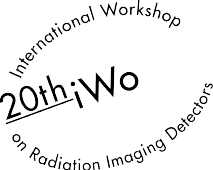Speaker
Description
The Timepix3 hybrid pixel detector’s precise time resolution of 1.5625 ns is of particular interest for new beam instrumentation applications since it enables time-resolved bunch-by-bunch measurement of the beam [1]. A transverse beam profile monitor is currently under development for the CERN Proton Synchrotron (CPS) to provide non-destructive continuous measurements during a beam cycle. As protons travel through the vacuum of the accelerator residual gas is ionized; the liberated ionization electrons are accelerated by a strong electric field towards the Timepix3 hybrid pixel detectors where they are detected. The beam profile is inferred from the distribution of the detected ionization electrons.
Figure 1. Top: 3D Rendering of the beam profile instrument. Bottom: Example of data recorded from the Timepix3 hybrid pixel detectors showing the ionisation electrons from the beam.
In early 2017 a prototype instrument was installed and used successfully during the year to measure the time evolution of the transverse beam profile. This demonstrated for the first time at CERN the potential of using hybrid pixel detectors directly inside the accelerator beam pipe for a beam instrumentation application. Due to the highly radioactive environment inside the CPS a radiation hardened readout system has been designed to connect to the pixel detectors inside the vacuum. The electrical data signals from the Timepix3 are brought to an FPGA where packets of data are routed onto optical fibers using components from the GBT and Versatile Link projects. A first version of the readout system has successfully been used during 2017 and a new system is currently being developed to enable the full data rate of the Timepix3 detectors.
An overview of the instrument will be presented with particular emphasis on the radiation hardened readout electronics for the Timepix3 detectors. Measurements from the 2017 run demonstrating the potential of hybrid pixel detectors for beam instrumentation will be shown.
REFERENCES
[1] POIKELA, T., et al. Timepix3: a 65K channel hybrid pixel readout chip with simultaneous ToA/ToT and sparse readout. Journal of instrumentation, 2014, 9.05: C05013.B.




